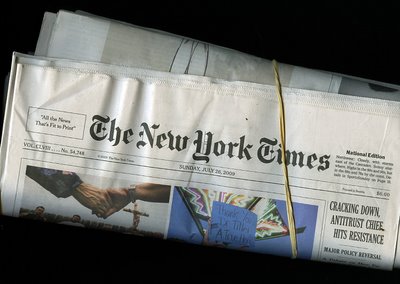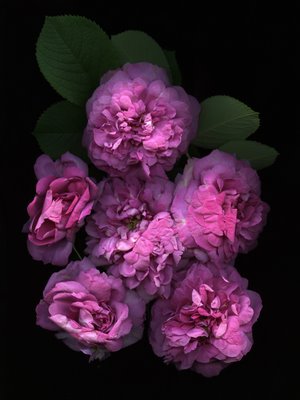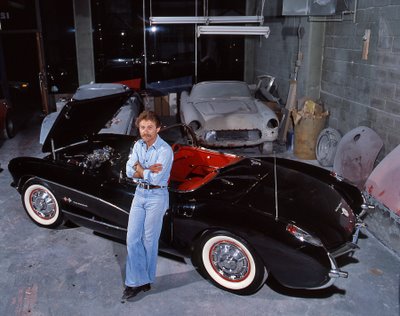Queso Tipo Roquefort & Breakfast (In Bed) With The NY Times
Saturday, July 25, 2009
I have never really liked smelly cheeses even though I cannot live without cheeses in general and I do adore some strong ones. It is all my mother’s fault. In Buenos Aires I remember that her favourite spread for her morning toast was “queso tipo Roquefort”. Even then she would point out to me that this was a very good Argentine imitation of her favourite cheese from the Combalou caves of Roquefort-sur-Soulzon. She sometimes combined it with jamón crudo as Argentines (at least then they were sticklers in not stepping on the toes of some of their European cousin’s patents) called Prosciutto di Parma. While I can blame my mother for ruining my possible enjoyment of smelly cheeses she did instill in me the idea that breakfast was a most important meal.
It was my grandmother who further taught me that breakfast was supposed to also be fun. She would smile as she would dip her toast (slathered with butter, strawberry jam and peanut butter) into her very sweet café con leche. Breakfast was never breakfast without her sweets.
For many years in Vancouver breakfast was a sit down affair at the dining room table. It became difficult to coordinate one breakfast with our different schedules and our two daughters’ schools. But we managed.
Nineteen years ago it all changed when my friend Mark Budgen suggested that instead of spending money and gas trying to secure the NY Times at a newsstand that it would be better if I obtained a daily delivered subscription. There was an enterprising Korean gentleman who would drive every day from the US border and deliver the paper in most of the lower mainland. He retired in Shaughnessy and the business of delivering the paper was taken over by the Globe & Mail.
Breakfast, with some few exceptions has been in bed since. Rosemary and I roughly alternate the days one of us goes down to prepare breakfast at around 6:30. My grandmother would not smile and my mother would have found it odd that I would have the previous evening’s cold pizza for breakfast. Pizza for breakfast is a rare occurrence but about 10 years ago we would often have bacon on Sundays.
It is simple now. Rosemary drinks decaf and on a few days of the week I make her cream of wheat with brown sugar. Of late, my roses have been happy with her as they share her bananas's potassium. Rosemary eats the inside with brown sugar and I cut up the peels and sprinkle them around my roses which grow all that much better.
My breakfast is a very large mug of very strong tea (made from loose tea in a large ball) a glass of juice (V-8 or apple, Rosemary likes grapefruit) and two Venice Bakery scissor rolls that I bake in the oven until they are very dark.

I don’t spread that tipo Roquefort on my bread but like my mother I enjoy those morning papers (the other one is the Vancouver Sun). And so does Rosemary. It seems that the day has not really begun until we silently (we never talk at breakfast) have our breakfast in bed and read our papers. Both of us follow the exploits of Rex Morgan.
A pomelo & queso tipo Roquefort
Chieftains Block The Shortcut That Was
Friday, July 24, 2009
My city has changed a lot since I first got to explore it in 1975. I was working for Tilden Rent a Car on Alberni Street. Before I was “promoted” to counter clerk I washed cars and jockeyed them to other Tilden locations includign the one at the airport. I had never driven automatic cars so my first experience with rental cars at Tilden was that I drove them with the right foot on the gas and the left foot on the brake. This did not work well and the car would jerk around. Nobody bothered to correct me. I guess they thought I drove like that. Eventually I caught on that one used only one foot.
It was driving to the airport that I discovered the few shortcuts that a city can have when it is a grid of north/south and east/west streets. Those shortcuts can be diagonals like Kinsgsway (impossible now with all those traffic lights) or Puget. Fir and Hemlock are shortcuts at certain times of the day when one wants to avoid “the little old ladies” that cross Granville as one of my buddy car jockeys used to comment. But on Sunday Granville is an easier way as Hemlock allows parking so only one lane each way is in operation. And we knew not to speed on the Arthur Laing Bridge. It was a Federal jurisdiction and tickets were much more expensive. It was at that time that learned to open any locked car in under three minutes with a coat hanger wire. Renters constantly lost keys or locked them inside.
Ultimately it was my knowledge of back alleys and how to avoid bad traffic intersections that allowed me on any given day to get to places more quickly (yet driving at the speed limit) than most people. Once, none of that helped except for that back alley savvy. Rosemary’s Audi 5000 (the one that was supposed to accelerate all on its own) would not do so even with my help. I found myself stranded on Cambie and 7th Avenue. I managed to get home (41st and Granville) by driving the Audi through most of the back alleys that I knew, in reverse gear, which was the only operational gear of the Audi’s automatic transmission which had given up the ghost.

And there was another time when I arrived late to a party. It was around 1980 and when going to town and specifically to West Van or North Van I used to take a shortcut which avoided the congested afternoon traffic to the North Shore. This was the road that hugged the waterfront and began in Gas Town and and paralleled the CP Rail tracks and ended on Georgia, right before Stanley Park. The road no longer exists now as it is all high rises and is traffic calmed. But back in 1980 taxi drivers knew the trick. There were a few speed bumps one had to be careful and every once in a while a train would block the way.
What blocked my way for close to an hour was not a train but the loading of British battle tanks (Chieftains) that had arrived to our harbour in a British Navy freighter. They were being loaded on to flat cars and railed to the Canadian Forces Base at Shiloh, Manitoba. NATO and particularly the German Army liked to have maneuvers in Shilo as the terrain imitated the plains of the Ukraine which is where the world thought WWIII might have to be fought.

It was a few weeks ago that driving to the Shaw Tower (I was going to be interviewed by Fanny Kiefer in her Studio 4 TV) where I almost could not recognize where I was. There were no landmarks left of the old road. The CP barge was long gone as were the railroad tracks. I could not even discern the ghosts of those tanks that had made me fume about arriving late to that party. I am only glad that I did have a camera so that the fading memory of those Leopard tanks (they weren’t Leopard tanks) that crossed my path 29 years is a memory of actual events. I remember telling my host, “I am late because some Leopards crossed my path.” Alas, they were Chieftans and if Kinsgsway is impossible now, Puget is a shortcut that still works just fine.
Eadric Silvaticus & Cloves In My Garden
Thursday, July 23, 2009
 Without knowing anything about this new David Austin English Rose I bought it and planted it in the centre rose bed. I knew it had rugosa parentage and this meant that the rose would be tough, floriferous and disease-free. Because I put it into the ground in early spring it did not bloom normally as it would have if I had planted it the year before. It has made up for lost time by blooming right now in big clusters of beautifully droopy almost messy clusters. The scent is intense and unique (read below). I go to the garden and smell my roses and I cannot figure out why more people do not do this. Why is it that they have also not discovered the wonders of the Fantastic period of music as the music of the 17th century is sometimes called? Or why is it that more people do not collect, as I do, as many versions of Gerry Mulligan playing My Funny Valentine? I guess the enjoyment is more intense simply because it is a lonely one. Shropshire rose grower, David Austin has this to say about Rosa 'Wild Edric': This is an unusually tough and reliable rose that will thrive even under difficult conditions and is not only suitable for the border, but it is ideal for semi-wild planting or for hedges. Its flowers start as attractively pointed, purple-pink buds. They gradually open to a semi-double flower of deep velvety pink with shades of purple and mauve, exposing a bunch of golden-yellow stamens that contrast with the colour of the petals. The overall fragrance is strong and delicious but interestingly, with a little investigation, a marked difference between the fragrance of the petals and the stamens can be detected. The latter is pure clove, whereas the former is classic Old Rose with hints of watercress and cucumber.
Wild Edric was a Saxon Lord in Shropshire, who was said to have married a fairy Queen. He reproached her one day and she disappeared. Legend has it that his ghost is still be to seen searching for her in the hills. 4 ft. x 4 ft. (1.2 m x 1.m).The Wikipedia has this to say about Wild Edric and it seems that it can also be written Eadric: Eadric the Wild or Eadric Silvaticus was a leader of English resistance to the Norman Conquest, active in western Mercia, 1068-70.
Arts Coverage Versus Yoga On A Bed Of Daisies
Wednesday, July 22, 2009
 Today I went to my second GVPTA Advocacy Committee meeting. I am not a member of the GVPTA (Greater Vancouver Professional Theatre Alliance) but I was an interested observer. All the different branches of the arts community in Vancouver, be they theatre, dance, music, opera and the visual arts are suffering from the combined blows of the economic downturn and the retreat of conventional media to the lifestyle topics of food, health and style. The GVPTA Advocacy Committee is attempting to address the problem and to find a solution. A well known news anchor at the Corporation told me that arts coverage is below their indicated spectrum of activity. My gracious and keen friend of the arts, Paul Grant will be history by the end of July at the CBC. The taking of the package at the Corporation precludes a de facto disappearance of the position held by the person retiring. Until the folks at that Corporation can figure out a new name for arts coverage or in a method to circumvent the prohibition of bringing it back, we will not have any. It was three months ago that I went to see a brilliant play at a well known theatre company’s venue. It was a Thursday opening. I noticed that our city newspaper’s critic was not there. I later found out that the critic had broken a leg. There was no review on the Saturday paper and this, I suspect, adversely affected attendance and the company must have lost money. A Wednesday review was too late to save the day. I pondered on how the fortunes of a theatre company depended on that one review. To be fair, a competing weekly paper, while being published on a Thursday (too late to review a play for the Saturday), does post reviews, as they are written, on its web page. But as I see it, with the fading of radio arts coverage (can Jian Ghomeshi be the one-size-fits-all arts reporter?) and the consideration that the making of tofu burritos and doing yoga while gardening on a bed of daisies is covering the arts in a newspaper, our local arts organizations have to find another way of making what they do known to the public. I called a local and very importan marketing manager of a Vancouver arts organizaton and I pressed to him my idea of something that I would call (in a most preliminary manner) a Vancouver Arts Web Hub. He was enthusiastic and immediately suggested that the key for its success would lie in a central core with a paid and independent editor, who would hire writers to write credible criticism, previews and essays on the arts. To make a very long story short we had a preliminary meeting and a steering committee is being put together. So far we have (I am the independent observer) Charles Campbell (former editor of the Georgia Straight, books editor of the Tyee, arts editor and opinion page editor for the Vancouver Sun), Amir Ali Alibhai (artist and Executive Director of the Alliance For Arts And Culture) and Nini Baird (as far as I know the only American woman to have received the Order of Canada and a powerful promoter of the arts). There are a few others who will join. The first mandate is to obtain funding as the complexity of a web site that would also incorporate all the participating web sites of Lower Mainland arts organization) will require money. The plan is to launch the site (a soft launch seems a realistic one) in the spring. Charles Campbell will probably be the independent editor suggested by the marketing manager I cited above. Max Wyman has informed me that he would be a keen contributor in writing for the Vancouver Arts Web Hub. I have in mind essays that would attempt to lure classical ballet enthusiasts to try modern dance or essays that would explain the importance of acting in opera or, why baroque music is not that much different from new music of the 21st century. It is my feeling that arts coverage should include more than previews and reviews. As an example I made the conscious choice of taking my 11 year old granddaughter to see the Playhouse presentation of the Electric Theatre Company’s Studies in Motion- The Hauntings of Eadweard Muybridge. It had full nudity which didn’t bother Rebecca in the least. She is now enthusiastic about theatre. I exposed her to her first Shakespeare play, The Comedy of Errors. She now wants to go to more Shakespeare. It will probably not be Othello but All’s Well That Ends Well. I have always felt that the media had the obligation in helping us become aware of the benefits of living a life surrounded by all the arts of which we have so many in Vancouver. And they rarely show us ways of inducing our younger ones to accompany us. Simon Ogden at today’s GVPTA Advocacy Committeee Meeting astounded us by telling us that in the Canadian theatrical community Vancouver is seen as cutting edge! Who would have known? We who live here do not understand the richness of our art scene. I read in the NY Times the constant reviews of classical ballet danced by imported dancers from Russia. I compare that to the variety of dance we have in Vancouver and I do believe we have the richer one. Charles Campbell published our proposed mandate in the blog of the Alliance for Arts and Culture here. I am quite excited at the prospect of having what in reality will be a Vancouver on line arts magazine that will incorporate also the finest arts blogs in town like Plank Magazine and Simon Ogden’s The Next Stage. The boy with the violin in the picture above is one of the first pictures I took of violinist Corey Cerovsek when he was 14.
A Rose Is Not A Rose When...
Tuesday, July 21, 2009
 Juliet: 'Tis but thy name that is my enemy.(40)
Thou art thyself, though not a Montague.
What's Montague? it is nor hand, nor foot,
Nor arm, nor face, nor any other part
Belonging to a man. O, be some other name!
What's in a name? That which we call a rose(45)
By any other name would smell as sweet.
So Romeo would, were he not Romeo call'd,
Retain that dear perfection which he owes
Without that title. Romeo, doff thy name;
And for that name, which is no part of thee,(50)
Take all myself. Romeo: I take thee at thy word.
Call me but love, and I'll be new baptiz'd;
Henceforth I never will be Romeo. Romeo and Juliet, Act 2 Scene 2, William Shakespeare Just about anybody can quote or remember part of the above: What's in a name? That which we call a rose
By any other name would smell as sweet.I beg to differ in one specific exception when the rose in question happens to be called Rosa ‘William Shakespeare’. Perhaps Shropshire rose hybridizer, David Austin, wanted to get part of the action associated with Shakespeare and roses by naming one after the bard. The rose is a beautiful but as David Austin writes about it in the Varieties That Have Been Superseded section of his book David Austin’s English Roses, New Edition, 1996:William Shakespeare (AUSROYAL) can produce some of the finest crimson Old Roses that anyone could wish to see. Its colour ranges from crimson to purple, to violet and mauve. The growth is very strong and upright. Sadly, it has shown tendency to rust and blackspot and would not pass our stringent tests we have today. Rich fragrance. W 90cm (3ft) x H 120 cm (4 ft). Breeding: ‘The Squire’ x ‘Mary Rose’. Introduced 1987.In 2000 Austin introduced an improved version, unpoetically called 'Shakespeare 2000' and as far as I am concerned it is not as sweet because of its name. Ealry this spring I noticed that my William Shakespeare was languishing and it was near death. I took it out of its spot and put it into a plastic pot and placed it in the middle of my stone path were it would get full sun and bake a bit. It prospered and I was so happy! Shakespeare was not dead. It was going to survive. Had it died there would be no replacement except for Shakespeare 2000 (ugh!). But that was not to be. My Lazarus-like plant had a but and the bud was orange red. When it opened I knew it was another plant I never really cared for in spite of its beautiful name. It was Rosa ‘Ainsley Dickson’ a rose we never suspected to be salmon pink and a colour that Rosemary dislikes. I had relegated the rose to an out of the way spot around other roses. It had somehow survived. I gave the rose to my friend Paul Leisz who loves the colour. Now if this wasn’t William Shakespeare…. I immediately went back to my rose bed and there he was, nice, strong and vigorous and, in my garden, all the rose that its maker says it isn’t! When a rose is called William Shakespeare, it has to be more than a rose. It has to be a special rose that both Rebecca and I especially love. We saw the display of a brand new Shakespeare 2000 in our rose bed. We liked the blooms but we are snobs and as far as we are concerned only William Shakespeare (the rose) is the real William Shakespeare. The picture you see here is what Rosa 'William Shakespeare' looked like late afternoon today when I scanned it.
Maurice Chevalier Would Approve
Monday, July 20, 2009

The only male in our house besides this blogger is Rosemary’s cat, Toby. I have my female cat Plata and when Hilary comes over with her two girls I am pleasantly surrounded by women. I can think of nothing better. Such was my fear that my paradise would be destroyed by the advent of a little boy that I went as far as informing Hilary (she was pregnant) that if she had a little boy I was going to disown her. I never had to exercise my threat as Lauren was born, 7 years ago. To watch two little girls (Rebecca is now not that little at almost 12) play in our garden is a delight that makes all the hours of garden work seem all worthwhile.
Last Saturday I caught Lauren in a serious mood while she was sitting on one of our lawn chairs. This is not characteristic of her as she smiles and laughs all the time. But I had photographed a serious (always serious for my photos) Rebecca minutes before so perhaps Lauren was just imitating her. Minutes after, the two girls began to dance and Rebecca gave Lauren some ballet lessons. I snapped with my Nikon FM loaded with Kodak Plus X and felt in my 20s again with the excitement of taking pictures just for fun.

The girls and Hilary returned today and for once Rosemary did not get her way and I made very thin pancakes. Rosemary says that pancakes can never feel like dinner. I tried a new recipe of baking bacon in the oven with lots of brown sugar. I served it with the pancakes. The girls used fruit syrups (we have several kinds) while Hilary decided on the Argentine dulce de leche.
This time around Rebecca taught Lauren how to make cartwheels after both sat in a children’s small plastic pool to cool off. I took the trio home and as I drove back I counted my three blessings and all those other women in my life. Toby and I are in our glory.
Fractals, Nodal Points & The Beauty Of Imperfection
Sunday, July 19, 2009
 |
| William Gibson - Alex Waterhouse-Hayward |
Laney’s node-spotter function [from Idoru] is some sort of metaphor for whatever it is that I actually do. There are bits of the literal future right here, right now, if you know how to look for them. Although I can’t tell you how; it’s a non-rational process.—William Gibson, August 1999
One of the more memorable incidents in Gibson’s 2007 novel Idoru involves a young woman who plans to have a video communication with a woman in Tokyo. She carefully plans what she is going to wear. Once she decides she buys her virtual clothing on the net. Her computer dresses here in these perfect designer clothes. Anybody in the room during the communication would mention something to the effect that the emperor is not wearing clothes. But the woman in Tokyo sees a beautifully dressed woman in an elegantly furnished room.
It is here that Gibson hits on one of his nodal points in which he observes that literal future now. Part of the woman’s computer program lays fractal dust on the surfaces of the virtually real furniture. The dust makes the room look lived-in and authentic.
That scene in Idoru has haunted me and especially now when I look at the photo assignments of my students. Their work is perfect. The imperfect human skin pore has been banished with the use of proprietary (every one of my students has a secret and personal process for this) Photoshop methods involving “healing tools”, “patch tools”, gaussian blurs and other methods like the oddly named "diffuse glow". Photo magazines display marvelous mountain scenes reflected on a pristine lake. The viewer cannot figure out which is the reflection and which is the real scene. The colours are punchy, bright and extremely sharp. Modern computer-designed lenses, even those with plastic elements, are uncommonly sharp. That uncommonly sharp scene can then be further sharpened with the Photoshop sharpening mode.
The above reminds me of the nouveau riche inhabitants of a new development, near ours in Arboledas, called Tecamachalco in the Mexico City I inhabited in the early 70s. These folk had beautifully designed homes and brand new cars. Wood tables marred easily so huge dining room tables were laminated with Formica and then further protected by thick sheets of plate glass. Lamp shades were protected from unsightly dust by being covered by clear plastic protectors. The upholstery of their Ford Galaxies and Mustangs were covered with a thick clear plastic. The purpose of all this was eternal newness.
Anybody who has ever purchased an expensive pair of shoes or a shiny new red bicycle can attest to the disappointment of having someone step on your shoe or that first fall in the red bike and the subsequent scratch of the red paint. If anything the deterioration of the house we live in, the garden we tend, the car we drive all remind us of the corruption and subsequent death of it.
We are temporarily distracted by the perfection and youth of babies and grandchildren. We repair the dent of the car fender. We long ago forgot that the purpose of paint was to stave off the rust of metal. The car will run dent or no dent. In the dawn of computer diagnostics for cars in the late 60s, the white uniformed German technician in my Mexico City VW dealer would show me in a computer print-out, the curves of the four pistons of my Beetle. He would point out how one of the pistons was leaking gas out of the cylinder. Compression was in decline. Time was taking its toll on my shiny new car.
This search for perfection killed Glen Gould’s desire to ever play a concert for and audience. He preferred the pristine environment of the studio. That he then “corrupted” these perfect recordings with his unusual humming perhaps prefigured William Gibson’s fractal dust. As for me I like the unexpected performance of a live performance. Violins make squeaks and when I listen to one of my favourite violinists, Marc Destrubé I enjoy hearing him breathe.
Gibson with his “nodal” ability to see future trends has already predicted one which I think may happily push perfection out of the way. Soon we will see panoramics of polluted lakes in Africa and photographs of women with skin pores and dazzling droopy breasts. Men will soon show of their tire handles and the antique business will be taken over by the former inhabitants of Tecamachalco who by now have discovered the wonders of rust, marred wooden tables and furniture and the beauty of decaying plants and imperfect and aging bodies.
The second photo here is a picture I took of Norm Necemer with his original everything (including paint) fuel injected Corvette. I took the photo around 1983. I am sure that Necemer probably still owns the car and it probably is beautifully looking worse for wear.

Now if I could only make my students understand the beauty of imperfection.
|



















